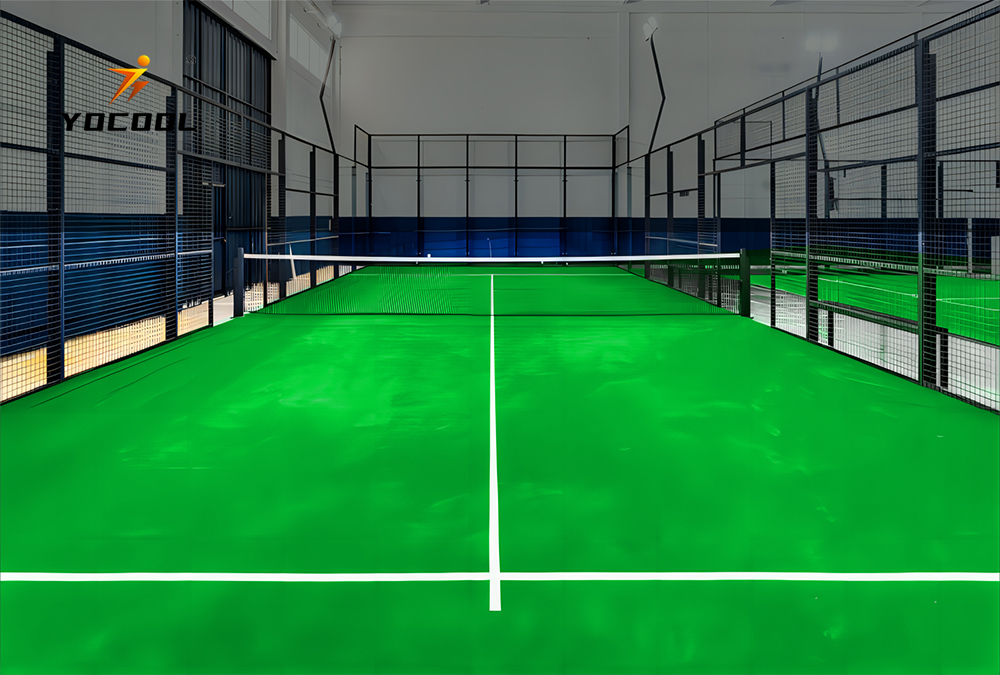1 – Size
Your choice of court size will be dictated by the amount of space you have available and the number of volleyball courts you want to include in your facility. The standard size for an indoor volleyball court is 60 feet by 30 feet, but you can find variations that are as small as 54 feet by 27 feet.
Knowing the competition, you will be hosting is crucial in choosing a court size for your facility. Higher levels of competition, such as NCAA matches, will require a standard-sized court.
Plan on hosting lower levels of competition or recreational play. You may be able to get away with a smaller court size.

2 – Surface
The surface of your indoor volleyball court also has an impact on cost.
PVC Floors
The most common type of surface for an indoor volleyball court is PVC. This synthetic surface offers a consistent and durable playing surface that is easy to maintain.
PVC floors are designed to be durable while keeping players safe. When athletes dive and slide for the ball, PVC limits the scrapes, abrasions, and burns associated with other materials.
Vulcanized Rubber Floors
Have a facility that will see much use? Vulcanized rubber is an excellent solution for high-traffic floors. Schools, event centers, and other public places often choose vulcanized rubber because of its incredible durability.
Vulcanized rubber is made by joining multiple layers of rubber together with heat and pressure. This process creates a flooring material that can withstand heavy use without showing wear and tear.
Vulcanized rubber floors are easier to install than their PVC counterparts. The installation process is less labor-intensive, leading to cost savings on your project.

Beyond the Surface
Below the surface of your court are the base and subfloor layers. These two pieces are crucial in providing a level and stable playing surface.
The base layer comprises materials such as concrete, asphalt, or rubber. The subfloor is typically made of plywood or particle board.
These layers add stability to the court and help reduce the impact on the players. The cost of these materials will be determined by the size of the court and the type of surface you choose.
Configuration
The configuration of your volleyball court also impacts the cost of construction. The most common type of indoor volleyball court is a single-court facility. This facility has one full-sized court that can be used for practice or competition.
If you have the space and budget, you may want to consider a double-court facility. This facility has two full-sized courts that can be used simultaneously for practice or competition.
Double-court facilities are more expensive to build and maintain, but they offer more flexibility.
Other Considerations regarding indoor volleyball court costs
In addition to the court, you will also need to consider the cost of lighting, seating, and storage.
Lighting
Indoor volleyball courts must be well-lit to provide a safe environment for players. The type of lighting you choose will impact the cost of your project.
The best type of lighting for an indoor volleyball court is LED. LEDs provide long-term cost savings and improved safety for athletes as modern technology.
LEDs are more expensive than traditional light bulbs but last longer and use less energy. You will save money on your electric bill in the long run.
Seating
If you plan on hosting competitions, you will need to provide seating for spectators. The seating cost will be determined by the size and type of seating you choose.
The most common type of seating for an indoor volleyball court is bleacher seating. Bleachers are a cost-effective solution that can be installed quickly.
Storage
You will also need storage for balls, nets, and other equipment. The storage cost will be determined by the size and type of storage you choose.
A locker room is the most common type of indoor volleyball court storage. Locker rooms provide a safe and secure place to store equipment when it’s not in use.
They also offer a place for athletes to change and shower after practice or competition.
Other “Physical” Considerations for your Indoor Volleyball Court
-
Line markings – every court needs competition lines. The more courts, the more complex the lines will be.
-
Sleeves and poles – volleyball isn’t volleyball without a quality net and suspension system.
-
Customization – you can place logos and custom colors on your court to reinforce branding and school spirit.

Geographic Considerations: Labor, Materials, Permits
The next set of factors to consider is your location. The construction cost will vary depending on your area’s labor, materials, and permits.
Labor
The local market rates will determine the cost of labor. In general, urban areas have higher labor costs than rural areas.
Materials
The cost of materials will also vary depending on your location and your source.
You can cut costs by ordering materials overseas. However, it would help if you worked with a trusted partner to avoid problems with quality or delivery.
Permits
The final cost consideration is permitted. Most cities and towns require a permit for any construction project. The cost of the permit will be determined by the size and scope of your project.

